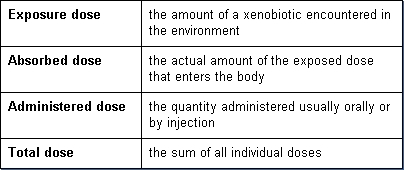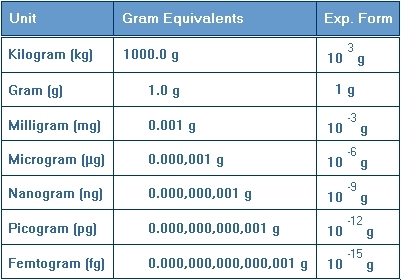Dose
Dose by definition is the amount of a substance administered at one time. However, other parameters are needed to characterize the exposure to xenobiotics. The most important are the number of doses, frequency, and total time period of the treatment. For example:
- 650 mg Tylenol as a single dose
- 500 mg Penicillin every 8 hours for 10 days
- 10 mg DDT per day for 90 days
There are numerous types of doses, e.g., exposure dose, absorbed dose, administered dose and total dose.
Fractionating a total dose can decrease the probability that the total dose will cause toxicity. The reason for this is that often the body can repair the effect of each subtoxic dose if sufficient time passes before receiving the next dose. In such a case, the total dose, harmful if received all at once, is non-toxic or less toxic, when administered over a period of time. For example, 30 mg of strychnine swallowed at one time could be fatal to an adult whereas 3 mg of strychnine swallowed each day for ten days would not be fatal.
The units used in toxicology are basically the same as those used in medicine. The gram is the standard unit. However, most exposures will be smaller quantities and thus the milligram (mg) is commonly used. For example, the common adult dose of Tylenol is 650 milligrams.
The clinical and toxic effects of a dose must be related to age and body size. For example, 650 mg is the adult dose of Tylenol. That would be quite toxic to young children, and thus Children's Tylenol tablets contain only 80 mg. A better means to allow for comparison of effectiveness and toxicity is the amount of a substance administered on a body weight basis. A common dose measurement is mg/kg which stands for milligram of substance per kilogram of body weight.
Another important aspect is the time over which the dose is administered. This is especially important for exposures of several days or for chronic exposures. The commonly used time unit is one day and thus, the usual dosage unit is mg/kg/day.
Since some xenobiotics are toxic in much smaller quantities than the milligram, smaller fractions of the gram are used, such as microgram (µg). Other units are shown below:
Environmental exposure units are expressed as the amount of a xenobiotic in a unit of the media.
- mg/liter (mg/l) for liquids
- mg/gram (mg/g) for solids
- mg/cubic meter (mg/m3) for air
Smaller units are used as needed, e.g., µg/ml.
Other commonly used dose units for substances in media are parts per million (ppm) which is often expressed as mg/L or mg/kg, parts per billion (ppb), expressed as ug/L or ug/kg, and parts per trillion (ppt), expressed as ng/L or ng/Kg.
| Disclaimer: This article is taken wholly from, or contains information that was originally published by, the National Library of Medicine. Topic editors and authors for the Encyclopedia of Earth may have edited its content or added new information. The use of information from the National Library of Medicine should not be construed as support for or endorsement by that organization for any new information added by EoE personnel, or for any editing of the original content. |

